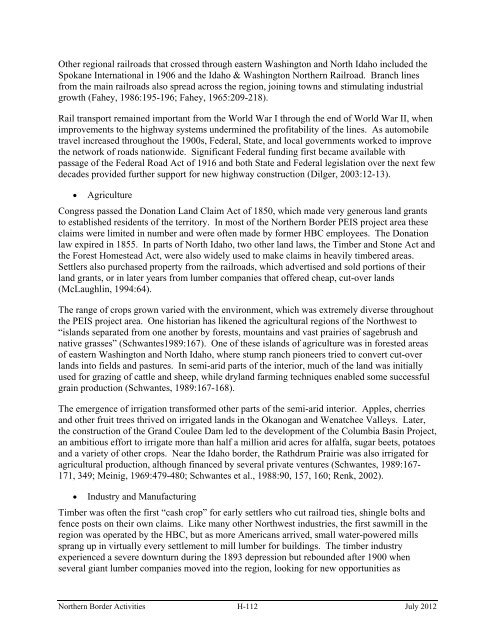Appendix H - Historical Archaeological and ... - CBP.gov
Appendix H - Historical Archaeological and ... - CBP.gov
Appendix H - Historical Archaeological and ... - CBP.gov
Create successful ePaper yourself
Turn your PDF publications into a flip-book with our unique Google optimized e-Paper software.
Other regional railroads that crossed through eastern Washington <strong>and</strong> North Idaho included the<br />
Spokane International in 1906 <strong>and</strong> the Idaho & Washington Northern Railroad. Branch lines<br />
from the main railroads also spread across the region, joining towns <strong>and</strong> stimulating industrial<br />
growth (Fahey, 1986:195-196; Fahey, 1965:209-218).<br />
Rail transport remained important from the World War I through the end of World War II, when<br />
improvements to the highway systems undermined the profitability of the lines. As automobile<br />
travel increased throughout the 1900s, Federal, State, <strong>and</strong> local <strong>gov</strong>ernments worked to improve<br />
the network of roads nationwide. Significant Federal funding first became available with<br />
passage of the Federal Road Act of 1916 <strong>and</strong> both State <strong>and</strong> Federal legislation over the next few<br />
decades provided further support for new highway construction (Dilger, 2003:12-13).<br />
<br />
Agriculture<br />
Congress passed the Donation L<strong>and</strong> Claim Act of 1850, which made very generous l<strong>and</strong> grants<br />
to established residents of the territory. In most of the Northern Border PEIS project area these<br />
claims were limited in number <strong>and</strong> were often made by former HBC employees. The Donation<br />
law expired in 1855. In parts of North Idaho, two other l<strong>and</strong> laws, the Timber <strong>and</strong> Stone Act <strong>and</strong><br />
the Forest Homestead Act, were also widely used to make claims in heavily timbered areas.<br />
Settlers also purchased property from the railroads, which advertised <strong>and</strong> sold portions of their<br />
l<strong>and</strong> grants, or in later years from lumber companies that offered cheap, cut-over l<strong>and</strong>s<br />
(McLaughlin, 1994:64).<br />
The range of crops grown varied with the environment, which was extremely diverse throughout<br />
the PEIS project area. One historian has likened the agricultural regions of the Northwest to<br />
“isl<strong>and</strong>s separated from one another by forests, mountains <strong>and</strong> vast prairies of sagebrush <strong>and</strong><br />
native grasses” (Schwantes1989:167). One of these isl<strong>and</strong>s of agriculture was in forested areas<br />
of eastern Washington <strong>and</strong> North Idaho, where stump ranch pioneers tried to convert cut-over<br />
l<strong>and</strong>s into fields <strong>and</strong> pastures. In semi-arid parts of the interior, much of the l<strong>and</strong> was initially<br />
used for grazing of cattle <strong>and</strong> sheep, while dryl<strong>and</strong> farming techniques enabled some successful<br />
grain production (Schwantes, 1989:167-168).<br />
The emergence of irrigation transformed other parts of the semi-arid interior. Apples, cherries<br />
<strong>and</strong> other fruit trees thrived on irrigated l<strong>and</strong>s in the Okanogan <strong>and</strong> Wenatchee Valleys. Later,<br />
the construction of the Gr<strong>and</strong> Coulee Dam led to the development of the Columbia Basin Project,<br />
an ambitious effort to irrigate more than half a million arid acres for alfalfa, sugar beets, potatoes<br />
<strong>and</strong> a variety of other crops. Near the Idaho border, the Rathdrum Prairie was also irrigated for<br />
agricultural production, although financed by several private ventures (Schwantes, 1989:167-<br />
171, 349; Meinig, 1969:479-480; Schwantes et al., 1988:90, 157, 160; Renk, 2002).<br />
Industry <strong>and</strong> Manufacturing<br />
Timber was often the first “cash crop” for early settlers who cut railroad ties, shingle bolts <strong>and</strong><br />
fence posts on their own claims. Like many other Northwest industries, the first sawmill in the<br />
region was operated by the HBC, but as more Americans arrived, small water-powered mills<br />
sprang up in virtually every settlement to mill lumber for buildings. The timber industry<br />
experienced a severe downturn during the 1893 depression but rebounded after 1900 when<br />
several giant lumber companies moved into the region, looking for new opportunities as<br />
Northern Border Activities H-112 July 2012
















